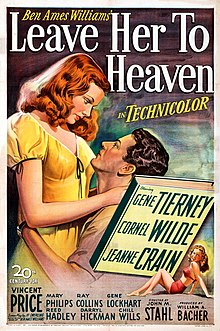
Back اتركها للجنة (فيلم) Arabic اتركها للجنه ARZ Que el cel la jutgi Catalan Leave Her to Heaven Welsh Todsünde (1945) German Ας την κρίνει ο Θεός Greek Que el cielo la juzgue Spanish Leave Her to Heaven Basque به خدا واگذارش کن Persian Péché mortel (film) French
| Leave Her to Heaven | |
|---|---|
 Theatrical release poster | |
| Directed by | John M. Stahl |
| Screenplay by | Jo Swerling |
| Based on | Leave Her to Heaven 1944 novel by Ben Ames Williams |
| Produced by |
|
| Starring | |
| Cinematography | Leon Shamroy |
| Edited by | James B. Clark |
| Music by | Alfred Newman |
| Color process | Technicolor |
Production company | 20th Century Fox |
| Distributed by | 20th Century Fox |
Release dates |
|
Running time | 110 minutes |
| Country | United States |
| Language | English |
| Box office | $8.2 million (worldwide rentals)[1] |
Leave Her to Heaven is a 1945 American psychological thriller film noir melodrama[2] directed by John M. Stahl and starring Gene Tierney, Cornel Wilde, Jeanne Crain, and Vincent Price. It follows a socialite who marries a prominent novelist, which spurs a violent, obsessive, and dangerous jealousy in her. It is based on the 1944 novel of the same name by Ben Ames Williams, adapted by screenwriter Jo Swerling.
Shot in Technicolor, filming took place in several locations in California, as well as Arizona and New Mexico[citation needed] in the summer of 1945. Leave Her to Heaven was released in the United States theatrically on December 20, 1945. The film was a box-office hit, grossing over $8 million, and was Twentieth Century-Fox's highest-grossing film of the entire decade.
In the decades following its release, Leave Her to Heaven garnered a cult following and has been the subject of film criticism for its unique blurring of genres, featuring elements of film noir, psychological thrillers, and melodramas. It has also been noted for its numerous visual and narrative references to figures in Greek mythology. The film's title is drawn from William Shakespeare's Hamlet, in which the Ghost urges Hamlet not to seek vengeance against Queen Gertrude, but rather to "leave her to heaven, and to those thorns that in her bosom lodge to prick and sting her."
In 2018, the film was selected for the United States National Film Registry by the Library of Congress as being "culturally, historically, or aesthetically significant."[3][4]
- ^ Solomon 2002, p. 65.
- ^ "Leave Her to Heaven". Filmsite.org. AMC Networks. Archived from the original on May 2, 2020. Retrieved May 2, 2020.
- ^ "National Film Registry Turns 30". Library of Congress. Retrieved May 2, 2020.
- ^ "Complete National Film Registry Listing". Library of Congress. Retrieved 2020-11-23.